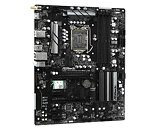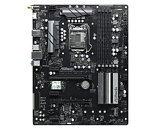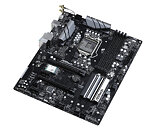Friday, May 1st 2020

ASRock Z490 Phantom Gaming 4SR First ATX12VO Motherboard in the DIY-channel
The winds of change are beginning. The ATX12VO PC power-supply standard, earlier thought to be an OEM-mainstay with later introduction in the DIY retail channel, has already reached it. The ASRock Z490 Phantom Gaming 4SR is the first board. Gone is the 24-pin ATX power connector, a smaller 5-pin pure-12 V input takes its place. A 6-pin PCIe connector takes in additional 12 V input. The 8-pin EPS connector (another pure-12 V input) is right where it should be, near the CPU VRM area. There are two small 4-pin connectors, which could be 5 V and 3.3 V outputs from the motherboard, to SATA power connectors.
The part of the PCB next to the memory area is bustling with a few more power phases than vDIMM. These convert 12 V to 5 V and 3.3 V (essentially what a PSU with DC-to-DC switching does). The rest of the board's I/O feature-set is fairly standard: four SATA ports, a single M.2-22110 slot, an M.2 E-Key slot holding an 802.11ac WLAN card, 6-channel audio, and 1 GbE wired networking driven by an Intel i219-V controller. The company didn't reveal pricing or availability.
Source:
madn3ss795 (Reddit)
The part of the PCB next to the memory area is bustling with a few more power phases than vDIMM. These convert 12 V to 5 V and 3.3 V (essentially what a PSU with DC-to-DC switching does). The rest of the board's I/O feature-set is fairly standard: four SATA ports, a single M.2-22110 slot, an M.2 E-Key slot holding an 802.11ac WLAN card, 6-channel audio, and 1 GbE wired networking driven by an Intel i219-V controller. The company didn't reveal pricing or availability.



40 Comments on ASRock Z490 Phantom Gaming 4SR First ATX12VO Motherboard in the DIY-channel
I agree, motherboard prices have gone nuts, but it's also worth considering that modern motherboards have a lot more of everything. This includes PCB quality, PCB layers, power phases, high-speed interfaces, etc. I guess you technically don't get more physical PCIe or SATA slots, but that's about the only thing that hasn't improved. Then we need to take inflation into account, which sadly makes things more expensive. However, the premium models also have, at least in the case of Asus, a 30-40% margin on top of them. How do I know this? Well, because I know a lot of people who works at the various board makers. I'm sure the other board makers have similar margins on their high-end boards too. After all, these companies are for profit businesses.
Yes, it makes it unfair towards those that don't earn a "western" salary. I'm far from a millionaire myself, but I'm lucky and I get a few bits here and there for free for my builds. Still, it's not as if computers are free for me either and we're at a point where a good gaming PC is getting out of reach for a lot of people. I can only guess how frustrating it is when it's something you're into and you can't afford to keep up.
Do I have a high-end PC? Sure I do, but I've had to save up for things as well, but I don't go around being angry at the world because things are expensive. I also use it for work, so it's not just for fun.
We live in an unfair world, but it sounds like you live in a very poor corner of the world, as even in Taiwan, the average salary is 2-3x what you earn and people aren't paid very high salaries in Taiwan. However, taking out your anger here, might not be the best place to do so, as you're only going to get angry reactions back.
Back in the days when I used to get a lot of free gear when I was doing 30-odd product group tests, I used to share what was left behind with friends all over the world. I have sent at least $2,000 worth of computer parts to a guy in South Africa that I met playing Warcraft II online and we still keep in touch to this day. He wouldn't have had nearly as good a computer as he was able to have back then, had it not been for me. If I still was in that situation, I'd be happy to send you some parts, but sadly I'm not. That said, I'm sure if you asked nice, there are people here that would be willing to part with some spare bits and pieces, but I guess it's easier to be angry at the world in general?
On the note of expensive motherboards, until I got the board I have now, I have mainly had mid-range boards, as they've done the job and I haven't needed/wanted the features on the high-end boards. I haven't seen the reason to go with something higher-end. However, this board had a few features I really liked and I had a so so experience with my previous Ryzen rig (which I btw sold very cheaply to a friend who had a potato PC). It wasn't that the board was bad, it just wasn't quite what I expected. I was thinking about getting a Ryzen 3900X, but I came to my senses, as I really don't need the extra four cores. I got the 3800X as I thought it would be a safer bet over the 3700X, as my 1700 wasn't nearly as good as the 1700X and 1800X. I turned out to be a bit of a bust this time around, as it performs within 2-3% of a 3700X, but such is life sometimes. In hindsight, I wish I'd saved $100 and gotten the 3700X. My graphics card was bought for the same as a 2070 Super, as for some reason they were going for "cheap" locally, when the Super cards launched. Yes, it's still a lot of money, but my second hand 4k screen needs a beefy graphics card. Yes, I bought my screen second hand, as there's no way I would've paid the full, new price for it. This is not a system that was paid for in a single lump sum, it's a system that has come together over time, as I always do when I upgrade my system.Well, I'm not sure I agree with your first statement. PSUs might in theory last longer, because you use the same PSU with two or three builds, but in reality, motherboards are likely to outlast PSUs in terms of longevity, if the system they're in continues to be used long past its prime.
Then you clearly know nothing about the cost of components, nor did you see my link above about the cost of Ethernet controllers. A lot of parts on motherboards costs a cent or two. The motherboard makers buy millions of these parts, so they get massive volume discounts.
Here's an example of a switching Voltage regulator from TI, it costs less than 50 cents if you buy 6k units. Imagine what it costs if you buy 250k units or more. www2.mouser.com/ProductDetail/Texas-Instruments/TPS56339DDCR
Sure, you need a few more parts, but they don't cost more than a few cents. So yes, it's possible that the additional cost is only $1.
Obviously there are margins added to the final product, but even so, the cost to you for this is not going to be more than $1.50-2.00.
These exact same parts are also inside the PSU you're buying today. So that cost would be removed from the PSU, plus the cost for the extra 14 wires that aren't needed for the main motherboard power connector any more and those wires are likely another 50 cents to a $1, as copper is quite expensive. As such, PSUs should end up being more affordable by moving to a 12V only design.
SATA is dying. It was supposed to be superseded by SATA Express, but that never happened for whatever reason. SATA isn't likely to be part of consumer motherboards in five years time. Hard drives interfaces on the server side are already moving to U.3 (also known as SFF-8639), although this has native support for SATA, SAS and NVMe, to simplify things. Will we see a new interface on the actual drives? I don't know, but there has been talk about a SATA/SAS replacement for years. NVMe is clearly the future for now, regardless of what people in this thread seems to think. Yes, flash storage is still comparatively costly per GB, but it's never been as cheap as it has been for the past year or so.
The PS/2 port is there for people that claim it has lower latency than USB and that it supports N-Key rollover. USB 2.0 are pretty much free, so the board makers throw them in as there's no real cost to them and it ticks a box. VGA and DVI are still both around, have a look on some of the boards that were just announced. All the cheaper boards have them for some reason...
Anyway, long story short, most of these people don't have 9900ks and 2080 ti's, I bet most of them have 6 cores or less and an older GPU or a 2060 or lower.
That being said im not againt progress but in this case we are not eliminating the need for 3,3V and 5V rails. We are just moving components from one part to another. Instead i would like to see some prototype boards created (even if they are just ideas to get the discussion going) that do away with most legacy ports and reposition the power connectors on boards. I really like what EVGA has done with their DARK series of boards. Placing all connectors at one spot, rotating them 90 degrees. So similar concept but taken further. Removing all but the latest USB standard ports. SATA ports. Removing all but one PCIe x16 slot and using the extra space for more M.2. Still ATX form factor. Perhaps even E-ATX (tho it's not a standard anyone follows to the letter).
Perhaps even having all the power connectors surrounding the CPU socket at the back of the board trough the cutout. Even budget cases have those now. Moving GPU power connectors from mid board back to rear (like it use to be before they were placed mid board due to HDD cages, cages we no longer have).
There are a lot of changes i would welcome but repositioning 3,3V andf 5V rails to motherboards? I don't get it. Eliminating them alltogether - yes.
I believe, as some other have pointed out here as well, that spinning rust will end up in NAS appliances or at least in external enclosures connected to a router or similar. Hard drives are noisy and slow and it's not something you want in your PC if you don't need them to be there. Sure, NAS appliances aren't free, but most half decent routers these days have a USB 3.0 port and external drives often cost no more or sometimes even less than internal drives.
Technically we are doing just that, as the onboard conversion for these Voltages will only be for a limited time. I see SATA SSDs being gone sooner than spinning rust drives, as in reality, there's no cost advantage of making an SSD using the SATA form factor over the M.2 form factor, regardless of the actual interface on the M.2 drive. We're seeing budget M.2 NVMe drives that challenge SATA SSDs in terms of price, while offering better performance in most cases.
Yes, we need a way to add more M.2 slots to a motherboard, as the current implementations are sub-optimal. I was expecting to see more vertical M.2 implementations, but apparently that's not become all that popular.
The ATX motherboard form factor is due for an overhaul, but it's a lot trickier than changing the PSU. Just look how badly it went for the BTX form factor...
Are there any limitations to usb or display port power supply worth noting I am sure power over Ethernet and display port can be upto 100watts.
Is any of this affected.
None of these questions are anything but interest , were all going to have to get onboard this given time so please see them as genuine questions of Interest.
The question I'm asking myself is that if there are still 24-pins present, just now spread across 4 connectors, what was the need to move away from a 24-pin connector?
The old 24pin had 3.3 and 5v feeds that are scarcely used.
Change equals more customers.
The PSU will be cheaper to make the board more expensive.
As for the point, god knows but server's have gone this route, well for some as have some OEM workstations so perhaps PSu makers want less sku's.
It's also important to note that as per the new standard, ONLY the 10-pin connector is mandatory. If a system doesn't need more power than the 288W that that connector provides, you can ship a board without any other power connectors. That means that for a board with only a single PCIe x16 slot and no SATA support, you need 75W for that slot and maybe 25W for all the other devices (chipset, M.2, etc.), which means 188W for the CPU alone. That should be more than enough for most ITX-size systems.
Here's a handy-dandy table I drew up from Intel's spec to hopefully make this all a bit clearer:
but Intel seems to think it's safe to pull almost double that
The ASRock board pictured here provides two of the Storage-4 connectors (my name for them), which means it can in theory power 8 SATA devices, despite the board having only 4 SATA data connectors. This makes sense, since a lot of auxiliary devices like AIO pumps and fan controllers use SATA power.
Note the insane "maximum wattage" values for the SATA output power connectors from the motherboard. The SATA specification dictates 1.5A per power pin, for a total of up to ~40W per connector - Intel has dropped this slightly to 35W (mostly by losing the 3.3V line), but that's still a LOT of watts for the motherboard to potentially generate.